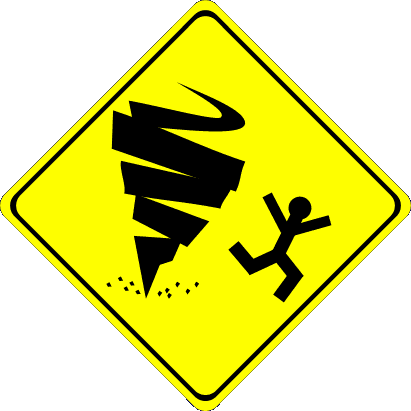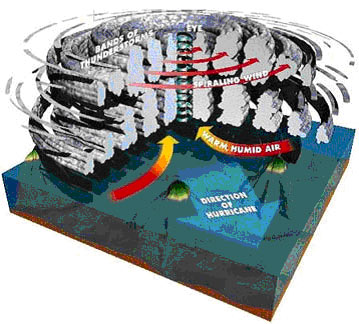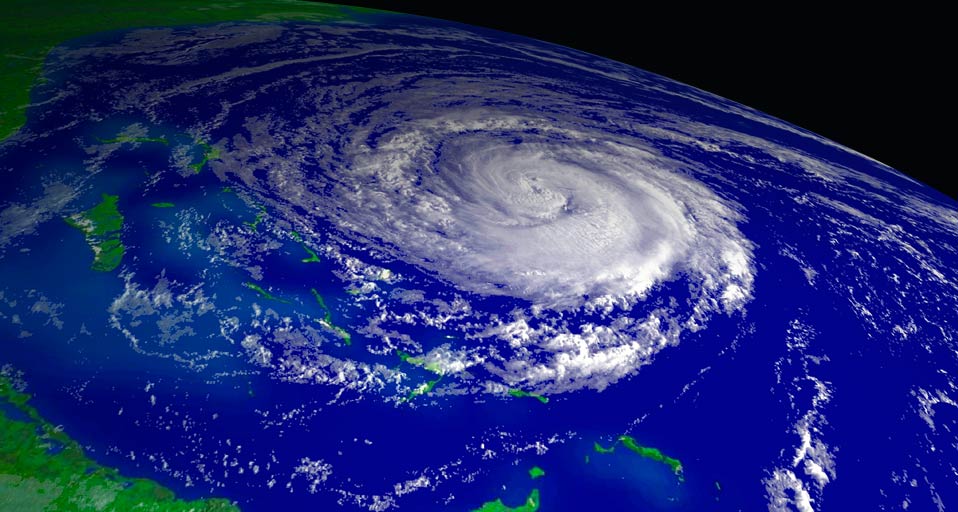 |
|
Welcome to the Hurricane Page!
|
|
| Homepage | |
| Concept Map | |
| Curriculum Web | |
| WebQuest | |
| Tornado | |
| Earthquake |
What is a hurricane?
A hurricane is a swirling storm measuring 60-1,000 miles in diameter that forms over warm ocean waters. Hurricanes start life as a cluster of strong thunderstorms moving across the ocean, called a tropical disturbance or tropical wave. Atmospheric conditions must be just right to turn a tropical wave into a hurricane — less than 5% of them ever become full-blown hurricanes.
A tropical wave that begins spinning around a center of low pressure is called a tropical depression. Tropical depressions have maximum sustained wind speeds of less than 40 mph at the ocean's surface. When the maximum winds reach 40 mph or greater, the storm changes into a tropical storm, and it's given a name. Once the maximum winds reach 74 mph or greater, the storm becomes a hurricane.
Each hurricane has an eye of calm winds and low pressure, surrounded by an eyewall of intense thunderstorms with high winds and heavy rain. Spiral bands of intense thunderstorms spiral into the eyewall of the hurricane from the outer parts of the storm.
The generic name for a hurricane is tropical cyclone. These storms are called typhoons when they occur in the western Pacific Ocean, and cyclones in the Indian and southern Pacific Oceans.
What does a hurricane look like?

What makes a hurricane?

- Ocean water temperatures of at least 80º Fahrenheit. This provides the storm with heat energy it needs to grow. That's why hurricanes in the Northern Hemisphere form in June through November, when ocean temperatures are warmest. September 10 is the peak of the Atlantic Ocean's hurricane season.
- Low wind shear from the top to the bottom of the atmosphere. For example, if the winds at the oceans' surface are light, and winds at high altitude over the tropical wave are strong, this "shear" will act to tear the developing hurricane apart.
- Something to get the tropical wave spinning. This is usually provided by a low-pressure system or front that moves from land over the tropical ocean. The part of the Earth's spin that points straight up at the point of interest, or the Coriolis force, must help get the storm spinning. Near the equator, the Coriolis force is zero, so no hurricanes form within about 500 miles of the equator.
Hurricanes typically last from two to fourteen days. They tend to move from east to west, at speeds between 10 and 30 mph. Their intensity is ranked on a scale of 1 to 5 called the Saffir-Simpson scale. This scale measures three types of activity: wind speed, air pressure, and storm surge. The storm surge is a 50 to 100-mile-wide dome of water that sweeps across the coastline near where a hurricane makes landfall.
How do they determine the "category"?
Category 3, 4, and 5 hurricanes are collectively referred to as intense or major hurricanes. These intense hurricanes cause over 70% of the damage in the United States, even though they account for only 20% of all hurricane strikes.
How do they name the hurricane?
Every tropical cyclone is given a name when it becomes strong and dangerous. The storm name is always used in all weather warnings. Using a name helps people tell one storm from another and follow its movements.
Official storm trackers all over the world have lists of names ready. The chosen hurricane names are used in a 6-year rotation, unless they're retired.
Once the 21 names chosen each year have been used, the Greek alphabet is used to name the storms.
"Retired" Names
Do you share a name with a famous historical hurricane?
Hurricane names are removed from the lists after they've been used for a storm that was very strong or caused a lot of damage.
These names won't be used again:
Allison, 2001; Agnes, 1972; Alicia, 1983; Allen, 1980; Andrew, 1992; Anita, 1977; Audrey, 1957
Betsy, 1965; Beulah, 1967; Bob, 1991
Camille, 1969; Carla, 1961; Carmen, 1974; Carol, 1965; Celia, 1970; Charley, 2004; Cleo, 1964; Connie, 1955
David, 1979; Dennis, 2005; Diana, 1990; Diane, 1955; Donna, 1960; Dora, 1964
Edna, 1968; Elena, 1985; Eloise, 1975
Fifi, 1974; Flora, 1963; Floyd, 1999; Fran, 1996; Frances, 2004; Frederic, 1979
Georges, 1998; Gilbert, 1988; Gloria, 1985; Gracie, 1959
Hattie, 1961; Hazel, 1954; Hilda, 1964; Hortense, 1996; Hugo, 1989
Inez, 1966; Ione, 1955; Iris, 2001; Isabel, 2003; Ivan, 2004
Janet, 1955; Jeanne, 2004; Joan, 1988
Katrina, 2005; Keith, 2000; Klaus, 1990
Luis, 1995
Marilyn, 1995; Mitch, 1998
Opal, 1995
Rita, 2005; Roxanne, 1995
Wilma, 2005
Why do they stop?
Hurricanes derive their energy from the water vapor that evaporates from warm ocean water. Therefore, when a hurricane moves over cold water or over land where it gets cut off from its energy source, it will die.
